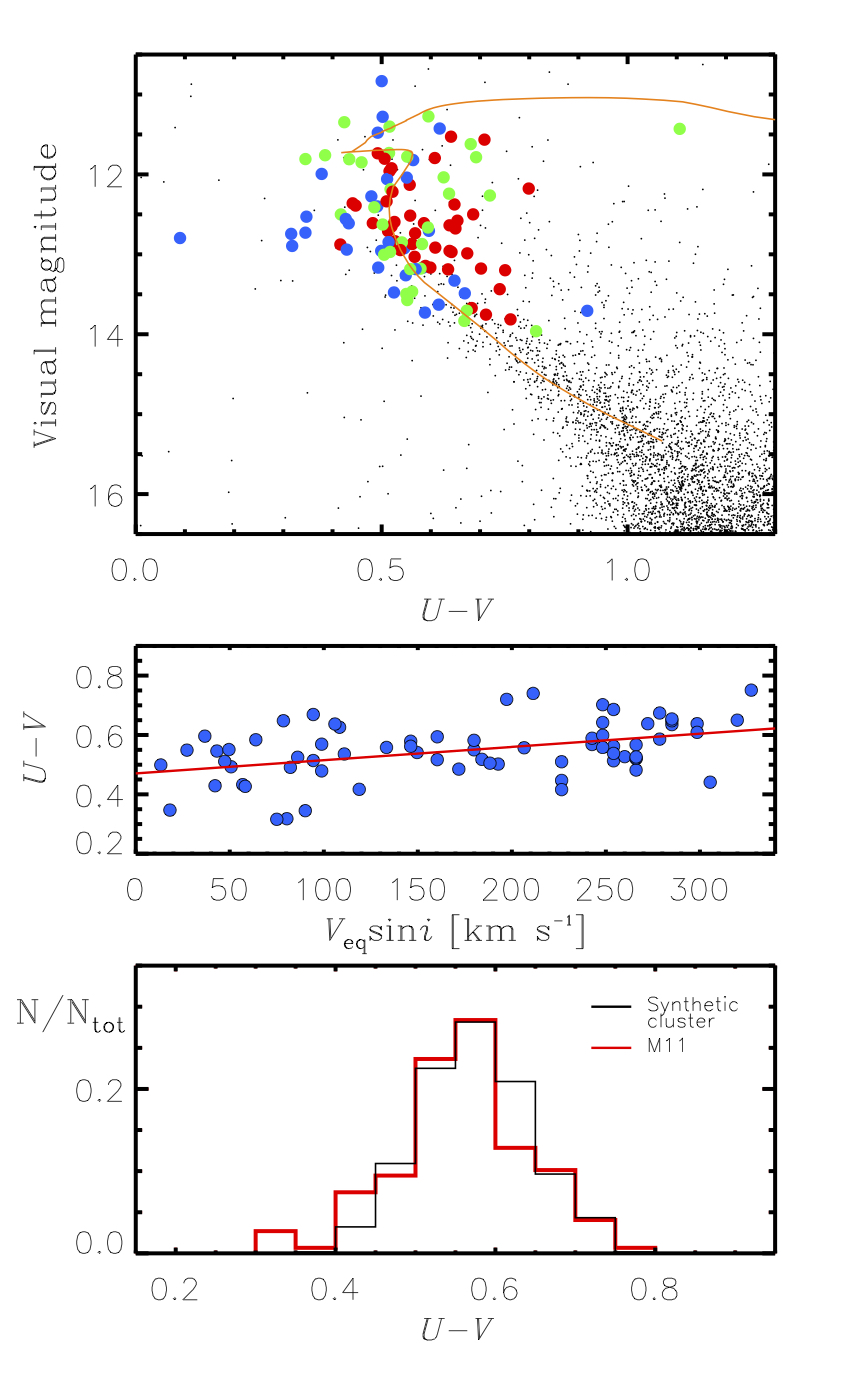IoW_20181106 - Gaia
Image of the Week |
secrets of the "Wild duck cluster" revealed |
 |
|
Figure 1: Top: Colour-magnitude diagram of the young open cluster M11. Blue, green, and red dots represent slow (Vsini < 100 km/s), moderate (100 km/s <= Vsini < 200 km/s), and fast rotators (Vsini > 200 km/s), respectively. The solid line is the Geneva isochrone for 2.5 million-year-old stars with a relative rotation rate of 0.7. Middle: Correlation between colours and Vsini, indicating faster rotating stars have redder colours than slower rotating stars. Bottom: Distribution of observed and synthetic colours, demonstrating the good match between the two. |
|
Stars are rarely born in isolation, and the formation of stellar clusters is still mostly to be understood. One of the remaining questions is whether star clusters comprise a single stellar population or result from multiple formation events. Indeed, while the former view was accepted in the past, the detection in the last decade of a colour spread at the main-sequence turn-off led researchers to envisage the presence of mutiple populations, formed over 100-200 million years. This, however, poses a problem for open clusters: their total mass generally is insufficient to be able to sustain multiple formation events, though a colour spread has been reported for them too. A new analysis done by a team of Korean and Belgian astronomers of the M11 cluster, located at 2 kiloparsec and harbouring about 3000 stars, sheds new light on this issue. First, the researchers assessed the membership of stars in the area using proper motions from Gaia data release 2. Then rotational velocities of cluster members were measured from high-resolution spectra taken at ESO in the framework of the GAIA-ESO public spectroscopic survey. Comparing them to the known colours of the stars already unveils a correlation between colour and rotation rates: the redder stars also are the fastest rotators. In fact, rotational mixing inside the stars brings fresh hydrogen to the core, thereby extending the main sequence lifetime by several tens of percent, explaining the colour spread at turn-off. But the astronomers wanted to dig further to even better understand what is happening. While the measured rotational velocities are projected velocities (V sin(i), with i the inclination angle and V the true rotational velocity) along our line-of-sight, the important parameters are the actual rotation rates. To constrain these, several possible distributions of true (equatorial) rotational velocities and inclination angles were considered. The best fit to the observations was found for stars with highly aligned spin axes and a broad distribution of equatorial velocities skewed towards high rotation rates. In other words: the spin axes of the stars in M11 are not randomly oriented. This is likely related to the formation process, and recent simulations have indeed suggested this can happen if the parent molecular cloud of the cluster has a strong rotation to begin with. Finally, also simulations for a synthetic cluster were performed using this best-fit underlying rotation distribution, the gravity darkening, the differential reddening and the Geneva stellar evolutionary models. The colour-magnitude diagram of M11 could then be reproduced using a single stellar population. The presence of multiple stellar populations is thus not required to explain the colour spread at the turn-off. The target of this study, M11, is also known as the "wild duck cluster" and was discovered in 1681. It is located at about 6,500 light years from us. Its name derives from the fact that the object occupies the 11th place in the catalogue compiled by Charles Messier. It can be easily observed with binoculars in the Scutum constellation. More info also in the press release of the University of Liège, and in the press release by the University of Arizona. The paper "Extended main sequence turn-off originating from a broad range of stellar rotational velocities" discussing this research was published on 5 November in Nature Astronomy. |
|
Credits: ESA/Gaia/DPAC, Beomdu Lim, Gregor Rauw, Yaël Nazé, Hwankyung Sung, Narae Hwang, and Byeong-Gon Park [Published: 06/11/2018] |
- Removed a total of (8) style text-align:center;
- Removed a total of (9) style text-align:justify;
- Removed a total of (3) style font-style:italic;
- Removed a total of (1) border attribute.
- Removed a total of (1) cellpadding attribute.
- Removed a total of (1) cellspacing attribute.
Image of the Week Archive
- Removed a total of (1) border attribute.
- Removed a total of (1) cellpadding attribute.
- Removed a total of (1) cellspacing attribute.








































 Sign in
Sign in
 Science & Technology
Science & Technology